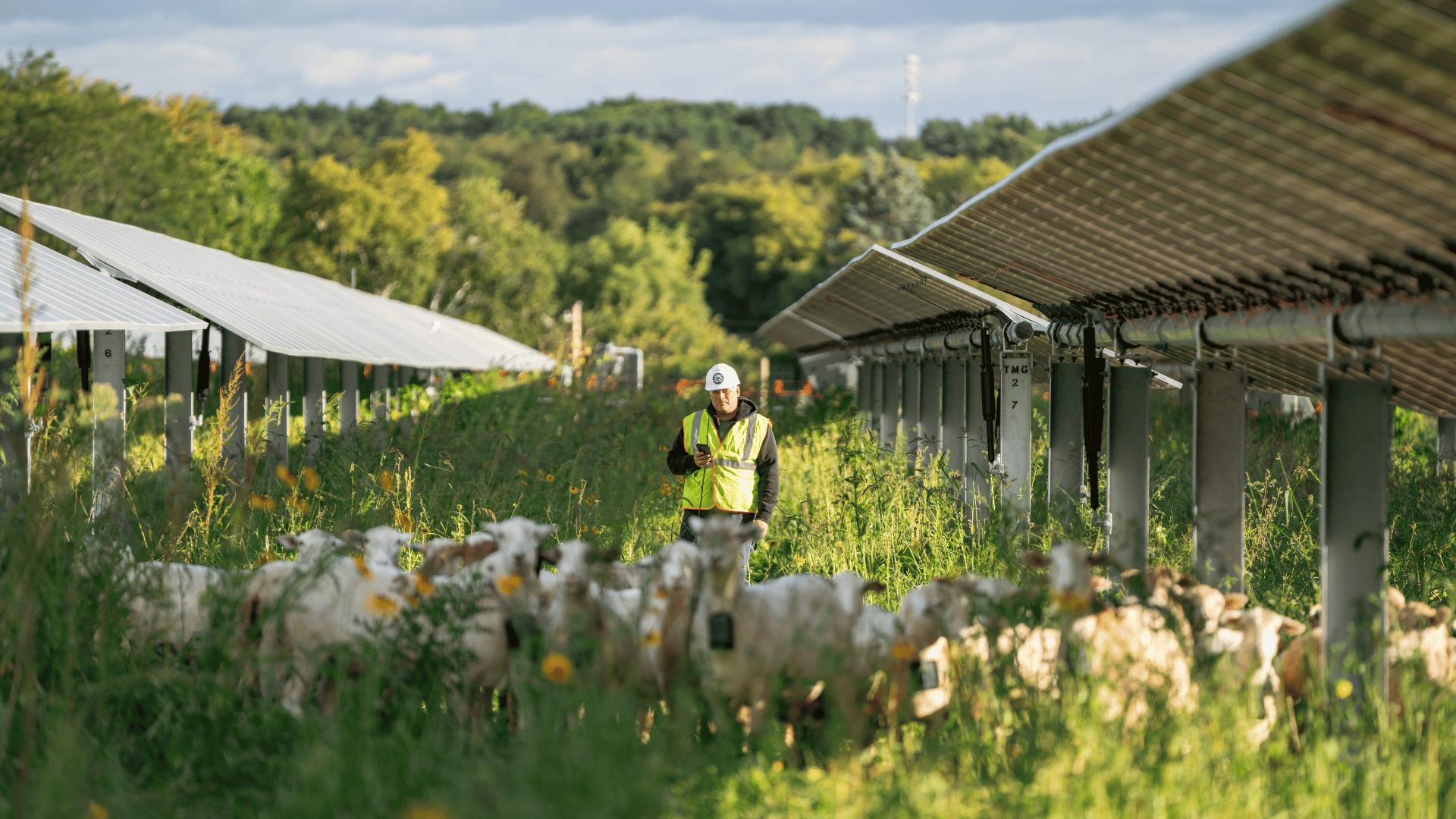
Under the Solar Panels, Pasture Management Finds New Ground
Across rolling pastures and rows of solar panels, Beau Stafford is pioneering a new way to merge renewable energy with regenerative agriculture. When he and his wife bought their farm, the dream was simple: raise a family with livestock and build a life close to the land. He never imagined that attending a local meeting about a new solar site down the road would open the door to an entirely new chapter.
Today, Wiscovery Farm manages over 200 sheep that graze both their home and several solar projects, keeping vegetation in check while improving the land beneath their hooves. With Nofence, Beau can move flocks from miles away while at work off the farm, saving hours of labor and giving him peace of mind knowing his flocks are where they should be. Virtual fencing is showing how stewardship and innovation can work side by side.

Solar Energy Meets Shepherding
When Beau Stafford and his wife Grace bought their southeastern Wisconsin farm in 2019, they thought it would be a small, straightforward operation: a few livestock, some hay production, enough to build a homestead. But just a year later, an opportunity shifted their path. A solar developer near their farm introduced Beau to the idea of solar grazing: using sheep to manage vegetation around and under solar panels.
What started with a handful of Katahdin sheep has grown into a thriving flock of about 200. Today, the Staffords run a busy farm and contract grazing business, where their livestock keep vegetation in check at renewable energy sites across the region. It is a model that works, but Beau admits the logistics were daunting.
“We’d set up polywire, move it, tear it down, all while juggling family life and contracts that required precise vegetation control,” he says. “On a 95-degree day in July, the last thing I wanted to do was spend hours putting up polywire. It just wasn’t sustainable.”

“I can increase the amount of grazable acreage by using collars on the ground I wouldn't fence otherwise. Not only that, I know exactly where my sheep are. I don't have to fear the unknown anymore”
— Beau Stafford

Turning Skepticism to Success
The last thing Beau wanted was to spend hours stringing up polynet fence. “It just wasn’t sustainable,” he says. That frustration pushed him to explore virtual fencing. Nofence stood out—not just as new technology, but as a practical solution to his biggest challenges.
Three benefits quickly rose to the top: uniform grazing across solar sites, major labor savings compared to polywire, and the peace of mind that comes with knowing exactly where his sheep are. Flexibility sealed the deal. “If we’re about to get rain and I know vegetation will explode, I can speed up grazing instantly from my phone,” Beau explains. “That kind of flexibility makes all the difference.”
He’ll admit he was skeptical at first. “The first time somebody mentioned virtual fencing, I said, ‘That’s not going to work.’ I was wrong.” But once the collars arrived, Beau was surprised by how quickly his flock adapted. Some learned right away, while others needed time to catch on. By pairing the quick learners with the stragglers, the whole flock soon understood the system.
Rolling out new technology with livestock came with its share of challenges, but overall the transition went smoothly. Each move became faster, every grazing rotation more consistent, and before long Beau was managing flocks from miles away—all from his phone.

“Agriculture has always been about innovation. Virtual fencing is one of those game-changers. For me, it’s not just about saving time. It’s about creating new opportunities for our farm and family."

A Clear Return
The results have been transformative. With Nofence, Beau can rotate sheep in seconds instead of hours, reclaiming time once lost to hauling and stringing polywire. “I know exactly where my sheep are. I don’t have to fear the unknown anymore,” he says.
The technology has also opened up new land. Areas he never would have fenced are now grazable, increasing his carrying capacity and supporting flock growth. For solar contracts, uniform grazing is critical, and Nofence gives Beau the confidence he can deliver season after season.
The lifestyle payoff matters just as much. With a newborn at home, the time savings and peace of mind allow Beau to step away from the fence line and spend more weekends with his family. “It gives me the freedom to be present with my kids instead of tied up in fencing work,” he explains.

Looking Ahead
Beau first adopted Nofence with the help of grant funding. Now he is ready to expand further, this time with his own investment. “That’s the biggest endorsement I can give. I’m willing to put my own money into more collars,” he says.
For him, virtual fencing is about more than economics. It is about sustainability, of land, contracts, and family life. “Agriculture has always been about innovation,” Beau reflects. “Virtual fencing is one of those game-changers. For me, it’s not just about saving time. It’s about creating new opportunities for our farm and family.”

